['Water Programs']
['Water Quality', 'Watershed Management']
05/03/2022
...
Methodology for Deriving Bioaccumulation Factors
Great Lakes States and Tribes shall adopt provisions consistent with (as protective as) this appendix.
I. Introduction
A. The purpose of this methodology is to describe procedures for deriving bioaccumulation factors (BAFs) to be used in the calculation of Great Lakes Water Quality Guidance (Guidance) human health Tier I criteria and Tier II values and wildlife Tier I criteria. A subset of the human health BAFs are also used to identify the chemicals that are considered bioaccumulative chemicals of concern (BCCs).
B. Bioaccumulation reflects uptake of a substance by aquatic organisms exposed to the substance through all routes (i.e., ambient water and food), as would occur in nature. Bioconcentration reflects uptake of a substance by aquatic organisms exposed to the substance only through the ambient water. Both BAFs and bioconcentration factors (BCFs) are proportionality constants that describe the relationship between the concentration of a substance in aquatic organisms and its concentration in the ambient water. For the Guidance in this part, BAFs, rather than BCFs, are used to calculate Tier I criteria for human health and wildlife and Tier II values for human health because they better account for the total exposure of aquatic organisms to chemicals.
C. For organic chemicals, baseline BAFs can be derived using four methods. Measured baseline BAFs are derived from field-measured BAFs; predicted baseline BAFs are derived using biota-sediment accumulation factors (BSAFs) or are derived by multiplying a laboratory-measured or predicted BCF by a food-chain multiplier (FCM). The lipid content of the aquatic organisms is used to account for partitioning of organic chemicals within organisms so that data from different tissues and species can be integrated. In addition, the baseline BAF is based on the concentration of freely dissolved organic chemicals in the ambient water to facilitate extrapolation from one water to another.
D. For inorganic chemicals, baseline BAFs can be derived using two of the four methods. Baseline BAFs are derived using either field-measured BAFs or by multiplying laboratory-measured BCFs by a FCM. For inorganic chemicals, BAFs are assumed to equal BCFs (i.e., the FCM is 1.0), unless chemical- specific biomagnification data support using a FCM other than 1.0.
E. Because both humans and wildlife consume fish from both trophic levels 3 and 4, two baseline BAFs are needed to calculate either a human health criterion or value or a wildlife criterion for a chemical. When appropriate, ingestion through consumption of invertebrates, plants, mammals, and birds in the diet of wildlife species to be protected may be taken into account.
II. Definitions
Baseline BAF.
For organic chemicals, a BAF that is based on the concentration of freely dissolved chemical in the ambient water and takes into account the partitioning of the chemical within the organism; for inorganic chemicals, a BAF that is based on the wet weight of the tissue.
Baseline BCF.
For organic chemicals, a BCF that is based on the concentration of freely dissolved chemical in the ambient water and takes into account the partitioning of the chemical within the organism; for inorganic chemicals, a BCF that is based on the wet weight of the tissue.
Bioaccumulation.
The net accumulation of a substance by an organism as a result of uptake from all environmental sources.
Bioaccumulation factor (BAF).
The ratio (in L/kg) of a substance's concentration in tissue of an aquatic organism to its concentration in the ambient water, in situations where both the organism and its food are exposed to and the ratio does not change substantially over time.
Bioconcentration.
The net accumulation of a substance by an aquatic organism as a result of uptake directly from the ambient water through gill membranes or other external body surfaces.
Bioconcentration factor (BCF).
The ratio (in L/kg) of a substance's concentration in tissue of an aquatic organism to its concentration in the ambient water, in situations where the organism is exposed through the water only and the ratio does not change substantially over time.
Biota-sediment accumulation factor (BSAF).
The ratio (in kg of organic carbon/kg of lipid) of a substance's lipid-normalized concentration in tissue of an aquatic organism to its organic carbon-normalized concentration in surface sediment, in situations where the ratio does not change substantially over time, both the organism and its food are exposed, and the surface sediment is representative of average surface sediment in the vicinity of the organism.
Depuration.
The loss of a substance from an organism as a result of any active or passive process.
Food-chain multiplier (FCM).
The ratio of a BAF to an appropriate BCF.
Octanol-water partition coefficient (KOW).
The ration of the concentration of a substance in the n-octanol phase to its concentration in the aqueous phase in an equilibrated two-phase octanol-water system. For log KOW, the log of the octanol-water partition coefficient is a base 10 logarithm.
Uptake.
Acquisition of a substance from the environment by an organism as a result of any active or passive process.
III. Review and Selection of Data
A. Data Sources. Measured BAFs, BSAFs and BCFs are assembled from available sources including the following:
1. EPA Ambient Water Quality Criteria documents issued after January 1, 1980.
2. Published scientific literature.
3. Reports issued by EPA or other reliable sources.
4. Unpublished data.
One useful source of references is the Aquatic Toxicity Information Retrieval (AQUIRE) database.
B. Field-Measured BAFs. The following procedural and quality assurance requirements shall be met for field-measured BAFs:
1. The field studies used shall be limited to those conducted in the Great Lakes System with fish at or near the top of the aquatic food chain (i.e., in trophic levels 3 and/or 4).
2. The trophic level of the fish species shall be determined.
3. The site of the field study should not be so unique that the BAF cannot be extrapolated to other locations where the criteria and values will apply.
4. For organic chemicals, the percent lipid shall be either measured or reliably estimated for the tissue used in the determination of the BAF.
5. The concentration of the chemical in the water shall be measured in a way that can be related to particulate organic carbon (POC) and/or dissolved organic carbon (DOC) and should be relatively constant during the steady- state time period.
6. For organic chemicals with log Kow greater than four, the concentrations of POC and DOC in the ambient water shall be either measured or reliably estimated.
7. For inorganic and organic chemicals, BAFs shall be used only if they are expressed on a wet weight basis; BAFs reported on a dry weight basis cannot be converted to wet weight unless a conversion factor is measured or reliably estimated for the tissue used in the determination of the BAF.
C. Field-Measured BSAFs. The following procedural and quality assurance requirements shall be met for field-measured BSAFs:
1. The field studies used shall be limited to those conducted in the Great Lakes System with fish at or near the top of the aquatic food chain (i.e., in trophic levels 3 and/or 4).
2. Samples of surface sediments (0-1 cm is ideal) shall be from locations in which there is net deposition of fine sediment and is representative of average surface sediment in the vicinity of the organism.
3. The Kow s used shall be acceptable quality as described in section III.F below.
4. The site of the field study should not be so unique that the resulting BAF cannot be extrapolated to other locations where the criteria and values will apply.
5. The tropic level of the fish species shall be determined.
6. The percent lipid shall be either measured or reliably estimated for the tissue used in the determination of the BAF.
D. Laboratory-Measured BCFs. The following procedural and quality assurance requirements shall be met for laboratory-measured BCFs:
1. The test organism shall not be diseased, unhealthy, or adversely affected by the concentration of the chemical.
2. The total concentration of the chemical in the water shall be measured and should be relatively constant during the steady-state time period.
3. The organisms shall be exposed to the chemical using a flow-through or renewal procedure.
4. For organic chemicals, the percent lipid shall be either measured or reliably estimated for the tissue used in the determination of the BCF.
5. For organic chemicals with log Kow greater than four, the concentrations of POC and DOC in the test solution shall be either measured or reliably estimated.
6. Laboratory-measured BCFs should be determined using fish species, but BCFs determined with molluscs and other invertebrates may be used with caution. For example, because invertebrates metabolize some chemicals less efficiently than vertebrates, a baseline BCF determined for such a chemical using invertebrates is expected to be higher than a comparable baseline BCF determined using fish.
7. If laboratory-measured BCFs increase or decrease as the concentration of the chemical increases in the test solutions in a bioconcentration test, the BCF measured at the lowest test concentration that is above concentrations existing in the control water shall be used (i.e., a BCF should be calculated from a control treatment). The concentrations of an inorganic chemical in a bioconcentration test should be greater than normal background levels and greater than levels required for normal nutrition of the test species if the chemical is a micronutrient, but below levels that adversely affect the species. Bioaccummulation of an inorganic chemical might be overestimated if concentrations are at or below normal background levels due to, for example, nutritional requirements of the test organisms.
8. For inorganic and organic chemicals, BCFs shall be used only if they are expressed on a wet weight basis. BCFs reported on a dry weight basis cannot be converted to wet weight unless a conversion factor is measured or reliably estimated for the tissue used in the determination of the BAF.
9. BCFs for organic chemicals may be based on measurement or radioactivity only when the BCF is intended to include metabolites or when there is confidence that there is no interference due to metabolites.
10. The calculation of the BCF must appropriately address growth dilution.
11. Other aspects of the methodology used should be similar to those described by ASTM (1990).
E. Predicted BCFs. The following procedural and quality assurance requirements shall be met for predicted BCFs:
1. The Kow used shall be of acceptable quality as described in section III.F below.
2. The predicted baseline BCF shall be calculated using the equation: predicted baseline BCF = Kow
where:
Kow = octanol-water partition coefficient.
F. Octanol-Water Partition Coefficient (Kow). 1. The value of Kow used for an organic chemical shall be determined by giving priority to the experimental and computational techniques used as follows:
Log KOW< 4:
| Priority | Technique |
| 1 | Slow-stir. |
| 1 | Generator-column. |
| 1 | Shake-flask. |
| 2 | Reverse-phase liquid chromatography on C18 chromatography packing with extrapolation to zero percent solvent. |
| 3 | Reverse-phase liquid chromatography on C18 chromatography packing without extrapolation to zero percent solvent. |
| 4 | Calculated by the CLOGP program. |
Log KOW> 4:
| Priority | Technique |
| 1 | Slow Stir. |
| 1 | Generator-column. |
| 2 | Reverse-phase liquid chromatography on C18 chromatography packing with extrapolation to zero percent solvent. |
| 3 | Reverse-phase liquid chromatography on C18 chromatography packing without extrapolation to zero percent solvent. |
| 4 | Shake-flask. |
| 5 | Calculated by the CLOGP program. |
2. The CLOGP program is a computer program available from Pomona College. A value of KOW that seems to be different from the others should be considered an outlier and not used. The value of KOW used for an organic chemical shall be the geometric mean of the available Kows with highest priority or can be calculated from the arithmetic mean of the available log KOW with the highest priority. Because it is an intermediate value in the derivation of a BAF, the value used for the KOW of a chemical should not be rounded to fewer than three significant digits and a value for log KOW should not be rounded to fewer than three significant digits after the decimal point.
G. This methodology provides overall guidance for the derivation of BAFs, but it cannot cover all the decisions that must be made in the review and selection of acceptable data. Professional judgment is required throughout the process. A degree of uncertainty is associated with the determination of any BAF, BSAF, BCF or Kow. The amount of uncertainty in a baseline BAF depends on both the quality of data available and the method used to derive the BAF.
H. Hereinafter in this methodology, the terms BAF, BSAF, BCF and KOW refer to ones that are consistent with the procedural and quality assurance requirements given above.
IV. Four Methods for Deriving Baseline BAFs
Baseline BAFs shall be derived using the following four methods, which are listed from most preferred to least preferred:
A. A measured baseline BAF for an organic or inorganic chemical derived from a field study of acceptable quality.
B. A predicted baseline BAF for an organic chemical derived using field- measured BSAFs of acceptable quality.
C. A predicted baseline BAF for an organic or inorganic chemical derived from a BCF measured in a laboratory study of acceptable quality and a FCM.
D. A predicted baseline BAF for an organic chemical derived from a KOW of acceptable quality and a FCM.
For comparative purposes, baseline BAFs should be derived for each chemical by as many of the four methods as available data allow.
V. Calculation of Baseline BAFs for Organic Chemicals
A. Lipid Normalization. 1. It is assumed that BAFs and BCFs for organic chemicals can be extrapolated on the basis of percent lipid from one tissue to another and from one aquatic species to another in most cases.
2. Because BAFs and BCFs for organic chemicals are related to the percent lipid, it does not make any difference whether the tissue sample is whole body or edible portion, but both the BAF (or BCF) and the percent lipid must be determined for the same tissue. The percent lipid of the tissue should be measured during the BAF or BCF study, but in some cases it can be reliably estimated from measurements on tissue from other organisms. If percent lipid is not reported for the test organisms in the original study, it may be obtained from the author; or, in the case of a laboratory study, lipid data for the same or a comparable laboratory population of test organisms that were used in the original study may be used.
3. The lipid-normalized concentration, Cl, of a chemical in tissue is defined using the following equation:
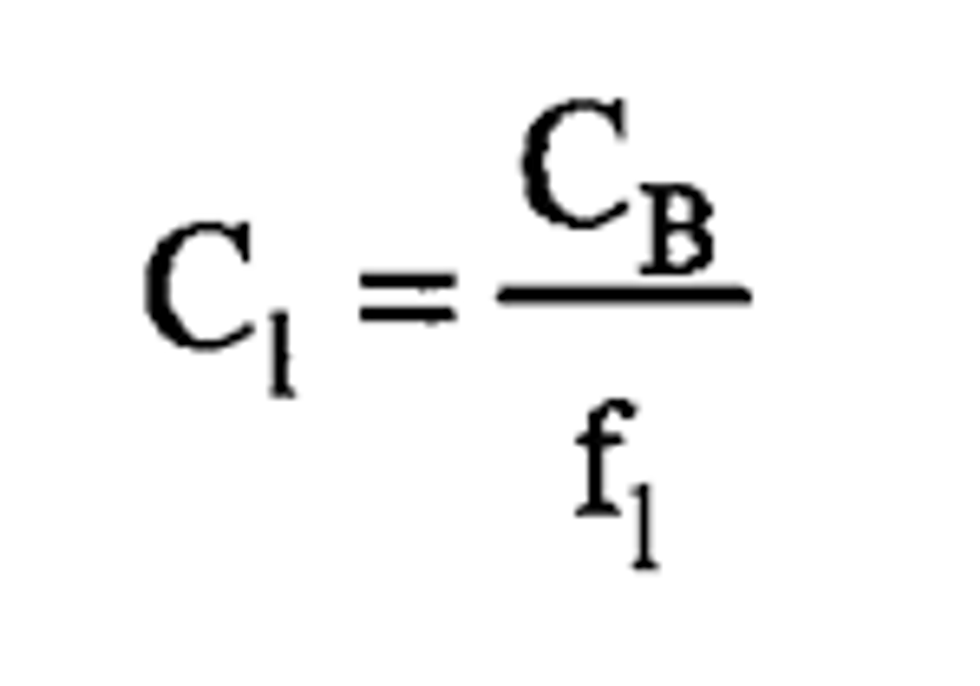
Where:
CB = concentration of the organic chemical in the tissue of aquatic biota (either whole organism or specified tissue) (µg/g).
fl = fraction of the tissue that is lipid.
B. Bioavailability. By definition, baseline BAFs and BCFs for organic chemicals, whether measured or predicted are based on the concentration of the chemical that is freely dissolved in the ambient water in order to account for bioavailability. For the purposes of this Guidance in this part, the relationship between the total concentration of the chemical in the water (i.e., that which is freely dissolved plus that which is sorbed to particulate organic carbon or to dissolved organic carbon) to the freely dissolved concentration of the chemical in the ambient water shall be calculated using the following equation:
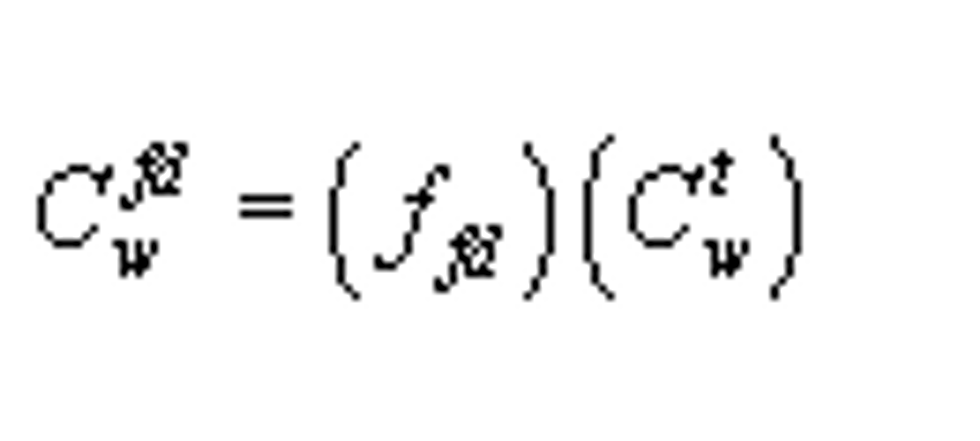
Where:
Cfd w = freely dissolved concentration of the organic chemical in the ambient water;
Ct w = total concentration of the organic chemical in the ambient water;
ffd = fraction of the total chemical in the ambient water that is freely dissolved.
The fraction of the total chemical in the ambient water that is freely dissolved, ffd, shall be calculated using the following equation:

Where:
DOC = concentration of dissolved organic carbon, kg of dissolved organic carbon/L of water.
KOW = octanol-water partition coefficient of the chemical.
POC = concentration of particulate organic carbon, kg of particulate organic carbon/L of water.
C. Food-Chain Multiplier. In the absence of a field-measured BAF or a predicted BAF derived from a BSAF, a FCM shall be used to calculate the baseline BAF for trophic levels 3 and 4 from a laboratory-measured or predicted BCF. For an organic chemical, the FCM used shall be derived from Table B-1 using the chemical's log KOW and linear interpolation. A FCM greater than 1.0 applies to most organic chemicals with a log KOW of four or more. The trophic level used shall take into account the age or size of the fish species consumed by the human, avian or mammalian predator because, for some species of fish, the young are in trophic level 3 whereas the adults are in trophic level 4.
D. Calculation of a Baseline BAF from a Field-Measured BAF. A baseline BAF shall be calculated from a field-measured BAF of acceptable quality using the following equation:

Where:
BAFt T = BAF based on total concentration in tissue and water.
fl = fraction of the tissue that is lipid.
ffd = fraction of the total chemical that is freely dissolved in the ambient water.
The trophic level to which the baseline BAF applies is the same as the trophic level of the organisms used in the determination of the field- measured BAF. For each trophic level, a species mean measured baseline BAF shall be calculated as the geometric mean if more than one measured baseline BAF is available for a given species. For each trophic level, the geometric mean of the species mean measured baseline BAFs shall be calculated. If a baseline BAF based on a measured BAF is available for either trophic level 3 or 4, but not both, a measured baseline BAF for the other trophic level shall be calculated using the ratio of the FCMs that are obtained by linear interpolation from Table B-1 for the chemical.
E. Calculation of a Baseline BAF from a Field-Measured BSAF. 1. A baseline BAF for organic chemical "i" shall be calculated from a field-measured BSAF of acceptable quality using the following equation:

Where:
(BSAF)i = BSAF for chemical "i".
(BSAF)r = BSAF for the reference chemical "r".
(KOW)i = octanol-water partition coefficient for chemical "i".
(KOW)r = octanol-water partition coefficient for the reference chemical "r".
2. A BSAF shall be calculated using the following equation:
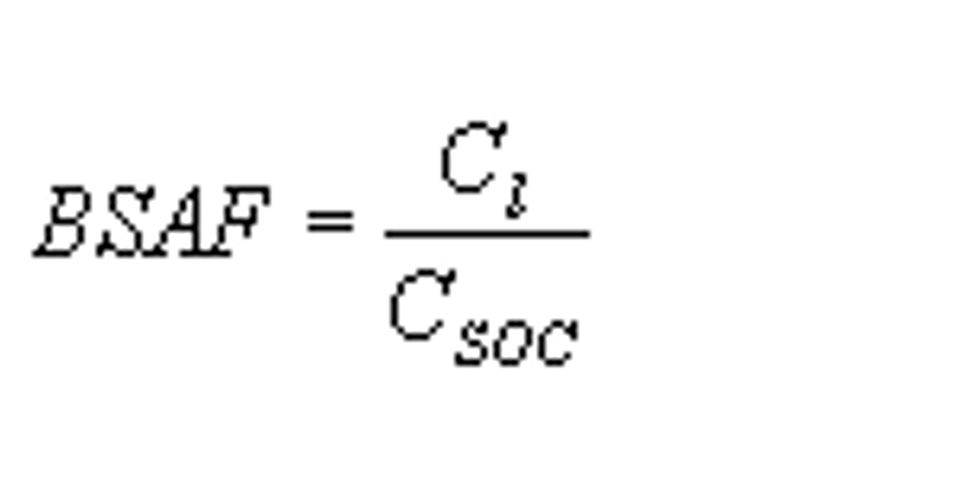
Where:
Ct = the lipid-normalized concentration of the chemical in tissue.
CSOC= the organic carbon-normalized concentration of the chemical in sediment.
3. The organic carbon-normalized concentration of a chemical in sediment, CSOC, shall be calculated using the following equation:
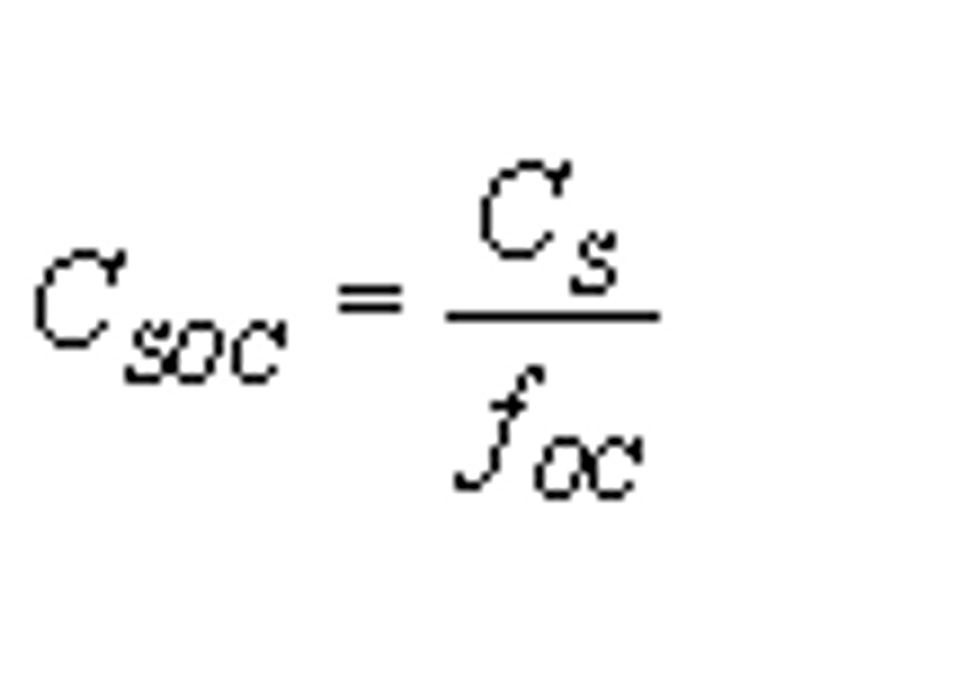
Where:
CS= concentration of chemical in sediment (µg/g sediment).
fOC= fraction of the sediment that is organic carbon.
4. Predicting BAFs from BSAFs requires data from a steady-state (or near steady-state) condition between sediment and ambient water for both a reference chemical "r" with a field-measured BAFlfd and other chemicals "n=i" for which BSAFs are to be determined.
5. The trophic level to which the baseline BAF applies is the same as the trophic level of the organisms used in the determination of the BSAF. For each trophic level, a species mean baseline BAF shall be calculated as the geometric mean if more than one baseline BAF is predicted from BSAFs for a given species. For each trophic level, the geometric mean of the species mean baseline BAFs derived using BSAFs shall be calculated.
6. If a baseline BAF based on a measured BSAF is available for either trophic level 3 or 4, but not both, a baseline BAF for the other trophic level shall be calculated using the ratio of the FCMs that are obtained by linear interpolation from Table B-1 for the chemical.
F. Calculation of a Baseline BAF from a Laboratory-Measured BCF. A baseline BAF for trophic level 3 and a baseline BAF for trophic level 4 shall be calculated from a laboratory-measured BCF of acceptable quality and a FCM using the following equation:

Where:
BCFt T = BCF based on total concentration in tissue and water.
f l = fraction of the tissue that is lipid.
ffd = fraction of the total chemical in the test water that is freely dissolved.
FCM = the food-chain multiplier obtained from Table B-1 by linear interpolation for trophic level 3 or 4, as necessary.
For each trophic level, a species mean baseline BAF shall be calculated as the geometric mean if more than one baseline BAF is predicted from laboratory-measured BCFs for a given species. For each trophic level, the geometric mean of the species mean baseline BAFs based on laboratory-measured BCFs shall be calculated.
G. Calculation of a Baseline BAF from an Octanol-Water Partition Coefficient. A baseline BAF for trophic level 3 and a baseline BAF for trophic level 4 shall be calculated from a KOW of acceptable quality and a FCM using the following equation:
Baseline BAF = (FCM) (predicted baseline BCF) = (FCM) (KOW)
Where:
FCM = the food-chain multiplier obtained from Table B-1 by linear interpolation for trophic level 3 or 4, as necessary.
KOW = octanol-water partition coefficient.
VI. Human Health and Wildlife BAFs for Organic Chemicals
A. To calculate human health and wildlife BAFs for an organic chemical, the KOW of the chemical shall be used with a POC concentration of 0.00000004 kg/L and a DOC concentration of 0.000002 kg/L to yield the fraction freely dissolved:
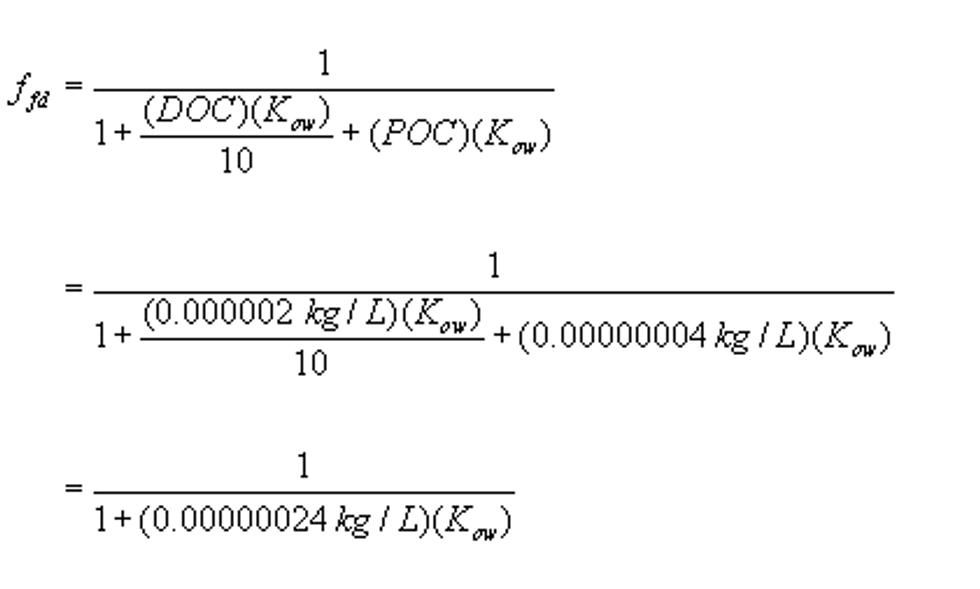
B. The human health BAFs for an organic chemical shall be calculated using the following equations:
For trophic level 3:

For trophic level 4:

Where:
0.0182 and 0.0310 are the standardized fraction lipid values for trophic levels 3 and 4, respectively, that are used to derive human health criteria and values for the GLI.
C. The wildlife BAFs for an organic chemical shall be calculated using the following equations:
For trophic level 3:

For trophic level 4:

Where:
0.0646 and 0.1031 are the standardized fraction lipid values for trophic levels 3 and 4, respectively, that are used to derive wildlife criteria for the GLI.
VII. Human Health and Wildlife BAFs for Inorganic Chemicals
A. For inorganic chemicals, the baseline BAFs for trophic levels 3 and 4 are both assumed to equal the BCF determined for the chemical with fish, i.e., the FCM is assumed to be 1 for both trophic levels 3 and 4. However, a FCM greater than 1 might be applicable to some metals, such as mercury, if, for example, an organometallic form of the metal biomagnifies.
B. BAFs for Human Health Criteria and Values.
1. Measured BAFs and BCFs used to determine human health BAFs for inorganic chemicals shall be based on edible tissue (e.g., muscle) of freshwater fish unless it is demonstrated that whole-body BAFs or BCFs are similar to edible- tissue BAFs or BCFs. BCFs and BAFs based on measurements of aquatic plants and invertebrates should not be used in the derivation of human health criteria and values.
2. If one or more field-measured baseline BAFs for an inorganic chemical are available from studies conducted in the Great Lakes System with the muscle of fish:
a. For each trophic level, a species mean measured baseline BAF shall be calculated as the geometric mean if more than one measured BAF is available for a given species; and
b. For each trophic level, the geometric mean of the species mean measured baseline BAFs shall be used as the human health BAF for that chemical.
3. If an acceptable measured baseline BAF is not available for an inorganic chemical and one or more acceptable edible-portion laboratory-measured BCFs are available for the chemical, a predicted baseline BAF shall be calculated by multiplying the geometric mean of the BCFs times a FCM. The FCM will be 1.0 unless chemical-specific biomagnification data support using a multiplier other than 1.0. The predicted baseline BAF shall be used as the human health BAF for that chemical.
C. BAFs for Wildlife Criteria.
1. Measured BAFs and BCFs used to determine wildlife BAFs for inorganic chemicals shall be based on whole-body freshwater fish and invertebrate data unless it is demonstrated that edible-tissue BAFs or BCFs are similar to whole-body BAFs or BCFs.
2. If one or more field-measured baseline BAFs for an inorganic chemical are available from studies conducted in the Great Lakes System with whole body of fish or invertebrates:
2. For each trophic level, a species mean measured baseline BAF shall be calculated as the geometric mean if more than one measured BAF is available for a given species.
b. For each trophic level, the geometric mean of the species mean measured baseline BAFs shall be used as the wildlife BAF for that chemical.
3. If an acceptable measured baseline BAF is not available for an inorganic chemical and one or more acceptable whole-body laboratory-measured BCFs are available for the chemical, a predicted baseline BAF shall be calculated by multiplying the geometric mean of the BCFs times a FCM. The FCM will be 1.0 unless chemical-specific biomagnification data support using a multiplier other than 1.0. The predicted baseline BAF shall be used as the wildlife BAF for that chemical.
VIII. Final Review
For both organic and inorganic chemicals, human health and wildlife BAFs for both trophic levels shall be reviewed for consistency with all available data concerning the bioaccumulation, bioconcentration, and metabolism of the chemical. For example, information concerning octanol-water partitioning, molecular size, or other physicochemical properties that might enhance or inhibit bioaccumulation should be considered for organic chemicals. BAFs derived in accordance with this methodology should be modified if changes are justified by available data.
IX. Literature Cited
ASTM. 1990. Standard Practice for Conducting Bioconcentration Tests with Fishes and Saltwater Bivalve Molluscs. Standard E 1022. American Society for Testing and Materials, Philadelphia, PA.
| Log KOW | Trophic level 2 | Trophic1 level 3 | Trophic level 4 |
| 2.0 | 1.000 | 1.005 | 1.000 |
| 2.5 | 1.000 | 1.010 | 1.002 |
| 3.0 | 1.000 | 1.028 | 1.007 |
| 3.1 | 1.000 | 1.034 | 1.007 |
| 3.2 | 1.000 | 1.042 | 1.009 |
| 3.3 | 1.000 | 1.053 | 1.012 |
| 3.4 | 1.000 | 1.067 | 1.014 |
| 3.5 | 1.000 | 1.083 | 1.019 |
| 3.6 | 1.000 | 1.103 | 1.023 |
| 3.7 | 1.000 | 1.128 | 1.033 |
| 3.8 | 1.000 | 1.161 | 1.042 |
| 3.9 | 1.000 | 1.202 | 1.054 |
| 4.0 | 1.000 | 1.253 | 1.072 |
| 4.1 | 1.000 | 1.315 | 1.096 |
| 4.2 | 1.000 | 1.380 | 1.130 |
| 4.3 | 1.000 | 1.491 | 1.178 |
| 4.4 | 1.000 | 1.614 | 1.242 |
| 4.5 | 1.000 | 1.766 | 1.334 |
| 4.6 | 1.000 | 1.950 | 1.459 |
| 4.7 | 1.000 | 2.175 | 1.633 |
| 4.8 | 1.000 | 2.452 | 1.871 |
| 4.9 | 1.000 | 2.780 | 2.193 |
| 5.0 | 1.000 | 3.181 | 2.612 |
| 5.1 | 1.000 | 3.643 | 3.162 |
| 5.2 | 1.000 | 4.188 | 3.873 |
| 5.3 | 1.000 | 4.803 | 4.742 |
| 5.4 | 1.000 | 5.502 | 5.821 |
| 5.5 | 1.000 | 6.266 | 7.079 |
| 5.6 | 1.000 | 7.096 | 8.551 |
| 5.7 | 1.000 | 7.962 | 10.209 |
| 5.8 | 1.000 | 8.841 | 12.050 |
| 5.9 | 1.000 | 9.716 | 13.964 |
| 6.0 | 1.000 | 10.556 | 15.996 |
| 6.1 | 1.000 | 11.337 | 17.783 |
| 6.2 | 1.000 | 12.064 | 19.907 |
| 6.3 | 1.000 | 12.691 | 21.677 |
| 6.4 | 1.000 | 13.228 | 23.281 |
| 6.5 | 1.000 | 13.662 | 24.604 |
| 6.6 | 1.000 | 13.980 | 25.645 |
| 6.7 | 1.000 | 14.223 | 26.363 |
| 6.8 | 1.000 | 14.355 | 26.669 |
| 6.9 | 1.000 | 14.388 | 26.669 |
| 7.0 | 1.000 | 14.305 | 26.242 |
| 7.1 | 1.000 | 14.142 | 25.468 |
| 7.2 | 1.000 | 13.852 | 24.322 |
| 7.3 | 1.000 | 13.474 | 22.856 |
| 7.4 | 1.000 | 12.987 | 21.038 |
| 7.5 | 1.000 | 12.517 | 18.967 |
| 7.6 | 1.000 | 11.708 | 16.749 |
| 7.7 | 1.000 | 10.914 | 14.388 |
| 7.8 | 1.000 | 10.069 | 12.050 |
| 7.9 | 1.000 | 9.162 | 9.840 |
| 8.0 | 1.000 | 8.222 | 7.798 |
| 8.1 | 1.000 | 7.278 | 6.012 |
| 8.2 | 1.000 | 6.361 | 4.519 |
| 8.3 | 1.000 | 5.489 | 3.311 |
| 8.4 | 1.000 | 4.683 | 2.371 |
| 8.5 | 1.000 | 3.949 | 1.663 |
| 8.6 | 1.000 | 3.296 | 1.146 |
| 8.7 | 1.000 | 2.732 | 0.778 |
| 8.8 | 1.000 | 2.246 | 0.521 |
| 8.9 | 1.000 | 1.837 | 0.345 |
| 9.0 | 1.000 | 1.493 | 0.226 |
['Water Programs']
['Water Quality', 'Watershed Management']
UPGRADE TO CONTINUE READING
Load More
J. J. Keller is the trusted source for DOT / Transportation, OSHA / Workplace Safety, Human Resources, Construction Safety and Hazmat / Hazardous Materials regulation compliance products and services. J. J. Keller helps you increase safety awareness, reduce risk, follow best practices, improve safety training, and stay current with changing regulations.
Copyright 2025 J. J. Keller & Associate, Inc. For re-use options please contact copyright@jjkeller.com or call 800-558-5011.
